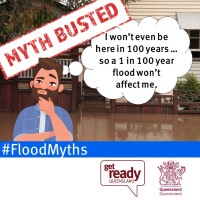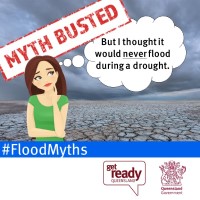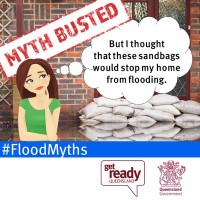Flood myths
There are a lot of misconceptions about floods. Here are nine flood myths to help support understanding of floods.
| Flood Myth | Image |
|---|---|
1. Myth busted! – 'But this property has never flooded before.'Floods bigger than those we have experienced are inevitable. We have less than 200 years of formal flood records in Australia. While there may be no living memory or formal record of your property flooding it does not mean that the land has not flooded in past centuries nor that it won’t flood in coming years. | 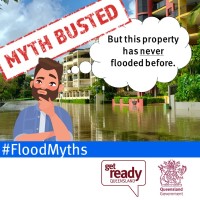 |
2. Myth busted! – 'But I live on a hill so floods won’t affect me.'Hills are not always free of floods. This can happen in two ways. 1. Creeks and rivers can rise several metres when they flood which means that land we think would be high and dry can end up being well under water. 2. When water is running down the hill to the creek or river it will find the easiest path to follow. Sometimes during a severe storm the pipes or kerb and guttering cannot handle all the water and the water will find its own path which could even be through properties on hills. Even if your property is not flooded, you may be isolated by floodwaters and you may not be able to leave or enter your property safely until floodwaters have subsided. | 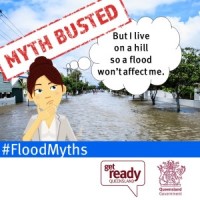 |
3. Myth busted! – 'But I don’t even live near a creek or a river so floods won’t affect me.'Water finds its way in unexpected places. This can happen in two ways. 1. When creeks and rivers burst their banks the water can spread several hundred metres (even kilometres). 2. When water is running down the hill to the creek or river it will find the easiest path to follow. Sometimes during a severe storm the pipes or kerb and guttering cannot handle all the water and the water will find its own path which could even be through properties on hills. | 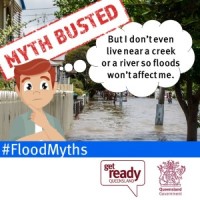 |
4. Myth busted! – 'My home is above the flood level so floods won’t affect me.'Floods can go higher than we plan for. In Australia, the flood planning level is usually defined by the 100-year flood. Floods can go higher than the 100-year flood level. This is not a flood which happens once every 100 hundred years but one which has a 1 in 100 or 1% chance of occurring in each and every year. In a 70 year lifetime there is a 50/50 chance of a 1 in 100 flood being exceeded at any location. Two such floods can occur one after the other. In 2007 rainfall exceeded the 1 in 100 event on the Sunshine Coast in Queensland, and again in 2011. | 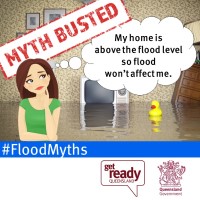
|
5. Myth busted! – 'But I won’t even be here in 100 years …so a 1 in 100 year flood won’t affect me.'Extreme floods can happen at any time. In Australia new buildings are usually built above the 100-year flood level. This is not a flood which happens once every 100 hundred years but one which has a 1 in 100 or 1% chance of occurring in each and every year. In a 70 year lifetime there is a 50/50 chance of a 1 in 100 flood being exceeded at any location. In fact, given the wet and dry phases that occur in many regions of Australia, these events are likely to be clustered in time. |
|
6. Myth busted! – 'We’re protected by levees where I live so flood won’t affect me.'Levees can provide limited protection to buildings and infrastructure. It is not practical to build levees high enough to keep out all floods. Every levee has a chance of being overtopped by floodwaters and as such, communities should be prepared to evacuate to reduce the exposure to flood risks. When a levee overtops or fails, the water may rise very quickly in the areas which the levee was protecting. Many have been built by individuals privately and may not be properly maintained. Failures of levees occur regularly and can result in worse flooding in areas directly behind the failed levee than would occur naturally. | 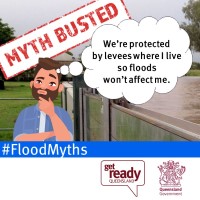
|
7. Myth busted! – 'But I thought that dams were supposed to stop all flooding.'Flood mitigation dams can reduce downstream flood levels by temporarily storing and later releasing floodwaters. Most dams are used to supply water to the community, but they can, when purpose built, also provide some flood mitigation for events up to their flood storage capacity. However, in larger floods, this mitigation capacity can be exceeded and floods pass through with little, if any, reduction. The effectiveness of dams depends on where in the catchment the rain falls. If it falls downstream of the dam, then the dam cannot mitigate flooding from that rainfall event. Dams can cause disruption to existing communities, loss of valuable land and negative environmental impacts, and good sites for dams are difficult to locate. Detention basins act like dams but at a much smaller scale and are most suitable for 'green field' developments, where sizing constraints tend not to exist. | 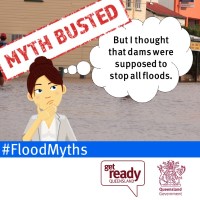
|
8. Myth busted! – 'But I thought it would never flood during a drought.'Flooding can happen at any time. Queensland has one of the most variable rainfalls in the world and experiences both regular and severe floods, and long droughts. In fact significant flooding, and even record rainfall and flooding can occur in the middle of a drought without the drought breaking. For example, the 25 January-14 February 2019 flooding from the North and Far North Queensland Monsoon Trough saw over half of Queensland’s councils, covering more than 56% of Queensland’s land mass, activated for disaster funding assistance. Prior to the Monsoon Trough, more than half of Queensland was suffering prolonged drought, and following the Monsoon Trough, 67.4% of Queensland was drought declared. |
|
9. Myth busted! – 'But I thought that these sandbags would stop my home from flooding.'Sandbags placed in appropriate locations around your home or business can reduce the impact of flooding. Sandbags will not stop the water completely, but can reduce the amount of water entering. Raising valuables off the floor may prevent damage to personal items from floodwater that may still enter. Queensland Fire Department (QFD) explains the correct process for sandbagging and answers the following frequently asked questions about sandbags (PDF | 19MB) including:
Watch the Queensland State Emergency Service (SES) video ‘How to sandbag your home and business’. |
|



